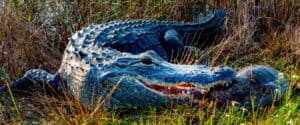Although Maryland is one of the smallest states in the U.S., it’s home to more than 20 different species of turtles! In total, around 19 of these species of turtles are native to Maryland, while three have been introduced and naturalized there over time. Below, we’ll take an in-depth look at 10 of the Old Line State’s most unique and fascinating turtles.
1. Midland Painted Turtle (Chrysemys picta marginata)
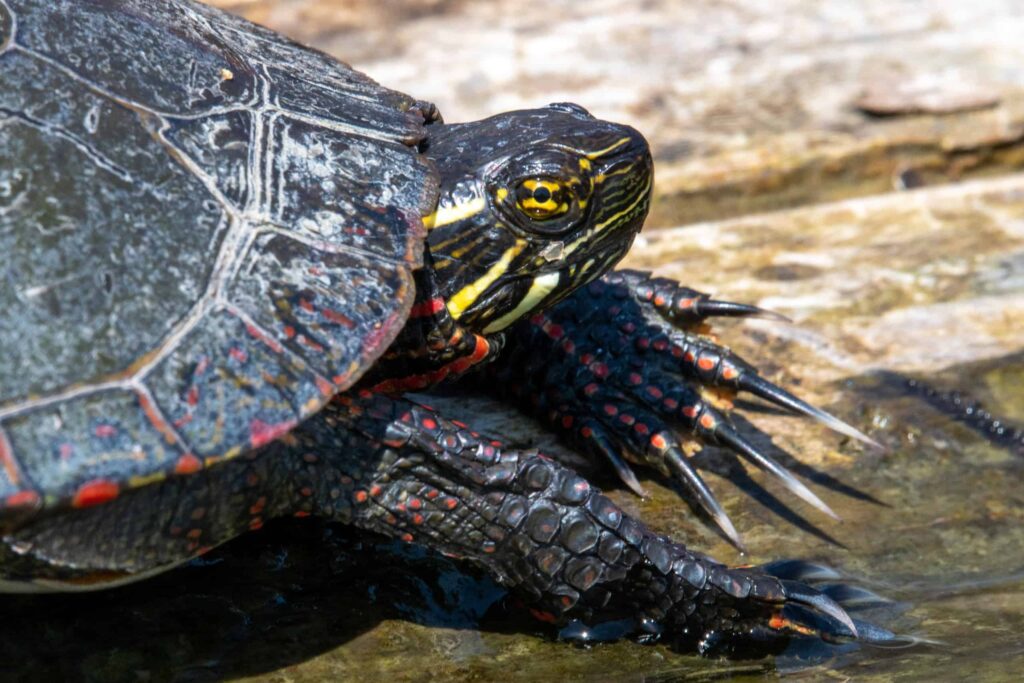
Midland painted turtles can be anywhere from 4 to 10 inches long.
©Lindaimke/Shutterstock.com
Collectively, painted turtles are the most widespread native turtles in North America! They are comprised of three total subspecies: the eastern, western, and midland painted turtles. Both the eastern and midland varieties can be found in Maryland, though the midland subspecies is most common in the northern and western parts of the state.
On average, the midland painted turtle is 4 to 10 inches long, with females being much longer and larger than males. Its dark brown carapace has a bright orange or red rim, though its underside, the plastron, is typically tan or yellowish. The center of its plastron has a faint dark brown shadow, which differentiates it from the other two painted turtle subspecies.
2. Striped Mud Turtle (Kinosternon baurii)
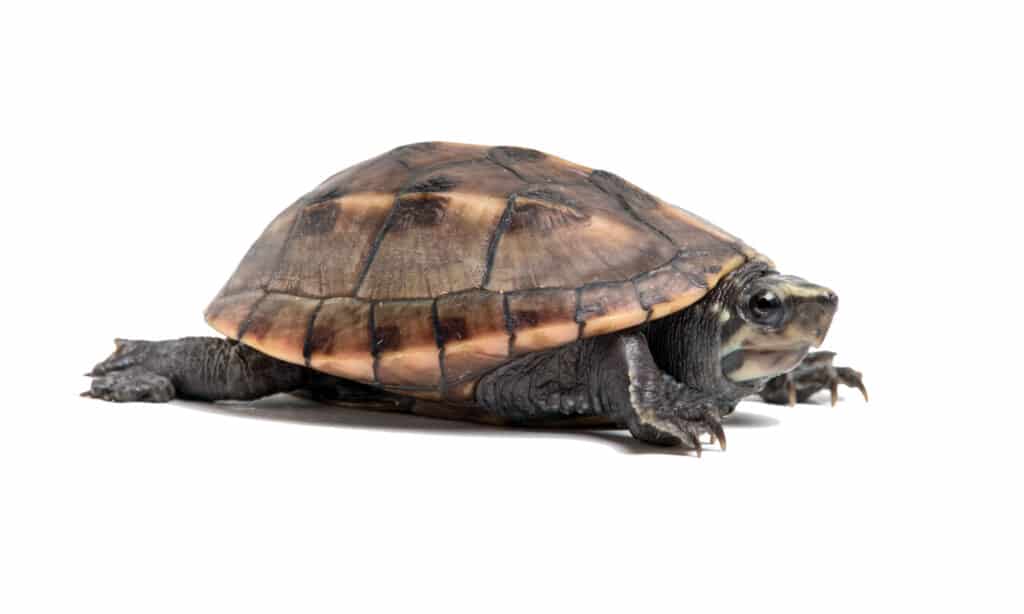
Maryland’s smallest turtle, the mud turtle, usually grows only 3-4 inches long.
©davemhuntphotography/Shutterstock.com
The striped mud turtle is one of Maryland’s smallest turtles at just 3 to 4 inches long on average. Like its name suggests, both its carapace and skin have unique stripes. Its dark greyish-brown skin has a light-yellow stripe running down either side of its face, while its dark brown carapace has three light brown lines running down it lengthwise. It has a short, pointed snout.
This tiny turtle lives throughout Maryland as well as much of the eastern United States. It can thrive in a wide range of freshwater habitats, including rivers, lakes, swamps, creeks, and more. Notably, it has also become quite popular in the pet trade due to its small size and hardy nature.
3. Eastern Box Turtle (Terrapene carolina carolina)
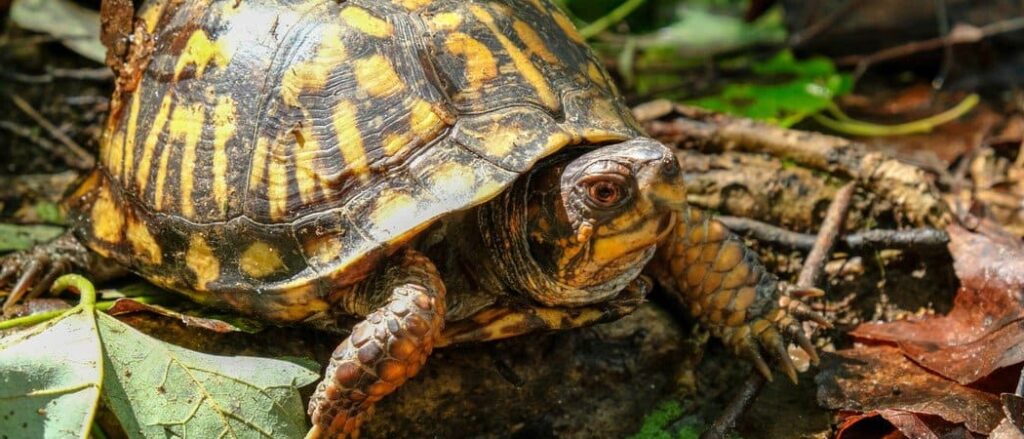
An eastern box turtle munches on a muscadine grape on the forest floor at Yates Mill County Park in Raleigh North Carolina. Eastern
box turtles live
in forested regions close to water.
©samray/Shutterstock.com
The eastern box turtle is one of Maryland’s only terrestrial turtle species. It’s actually one of seven total box turtle subspecies! Like all other box turtles, the bottom part of its shell, the plastron, is hinged. This allows the turtle to essentially “box” itself into its shell to protect itself from predators.
The typical eastern box turtle is around 4 to 6 inches long with a tall, dome-shaped carapace. Its skin and shell vary in color, though they are most commonly brown with lots of yellow or orange markings. Its limbs are strong and bulky for burrowing in mud and leaf litter. Interestingly, males have red eyes, while females’ eyes are usually brown.
Eastern box turtles can be found throughout Maryland in a variety of forested habitats, though they are never far from water. They tend to stick to a very small home range and don’t wander more than a mile or two from their home territory.
4. Common Snapping Turtle (Chelydra serpentina)
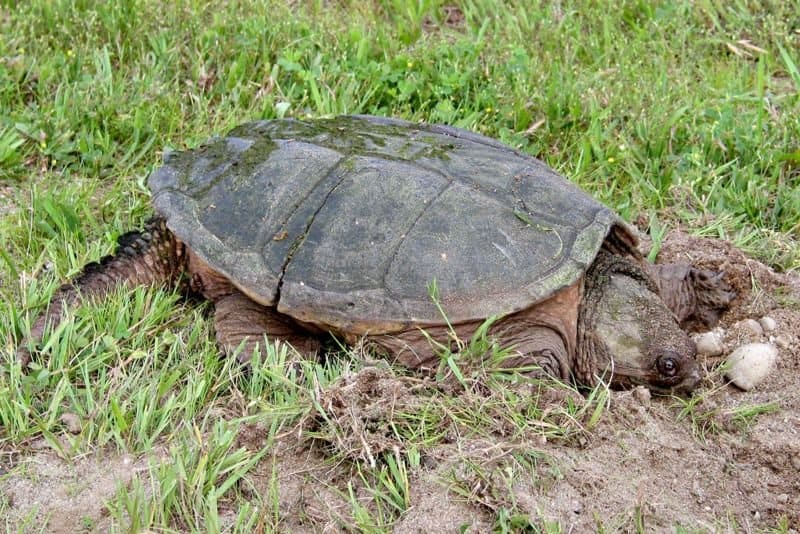
The common snapping turtle is the largest freshwater turtle in Maryland.
©Moondigger / Creative Commons – Original
The common snapping turtle is Maryland’s largest freshwater turtle, and it’s one of the largest freshwater turtle species in North America. It averages 8 to 15 inches long and can weigh well over 50 pounds! An incredibly hardy species, its geographic range covers most of the eastern half of United States and extends into southern Canada.
This massive turtle has large, strong legs and a very long, flexible neck. As you might guess just by its name, it has an extremely painful bite, though it tends to avoid humans and doesn’t bite unless provoked. Its shell and skin color vary, though it is typically greyish-brown with no markings. The underside of its shell, the plastron, is significantly reduced in size, which gives the turtle’s enormous limbs an excellent range of mobility.
5. Yellow-Bellied Slider Turtle (Trachemys scripta scripta)
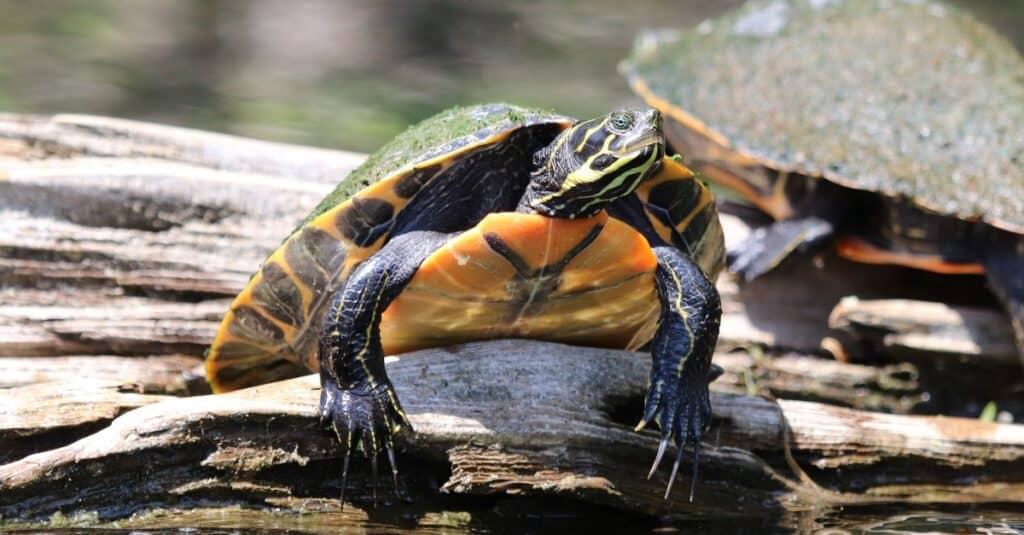
Yellow-Bellied Sliders like to rest on the logs in the Rainbow River in
Florida
. This
pond turtle
has a brown or green shell with yellow on its underside.
©iStock.com/jrubacha
The yellow-bellied slider is one of three unique subspecies of the pond slider turtle, meaning it is very closely related to the well-known and widespread red-eared slider turtle! Although the yellow-bellied slider is native to the southeastern U.S., it has been introduced to Maryland and now lives throughout the state in various freshwater habitats like rivers, ponds, and swamps.
Like most pond sliders, the yellow-bellied slider is fairly small at 5 to 8 inches long. Its skin is green with bold yellow striping throughout, and its plastron is similarly a vibrant, sunny yellow. Its greenish-brown carapace has a slightly raised central ridge, or keel, running down it lengthwise, and it often has a yellowish rim.
6. Eastern Painted Turtle (Chrysemys picta picta)
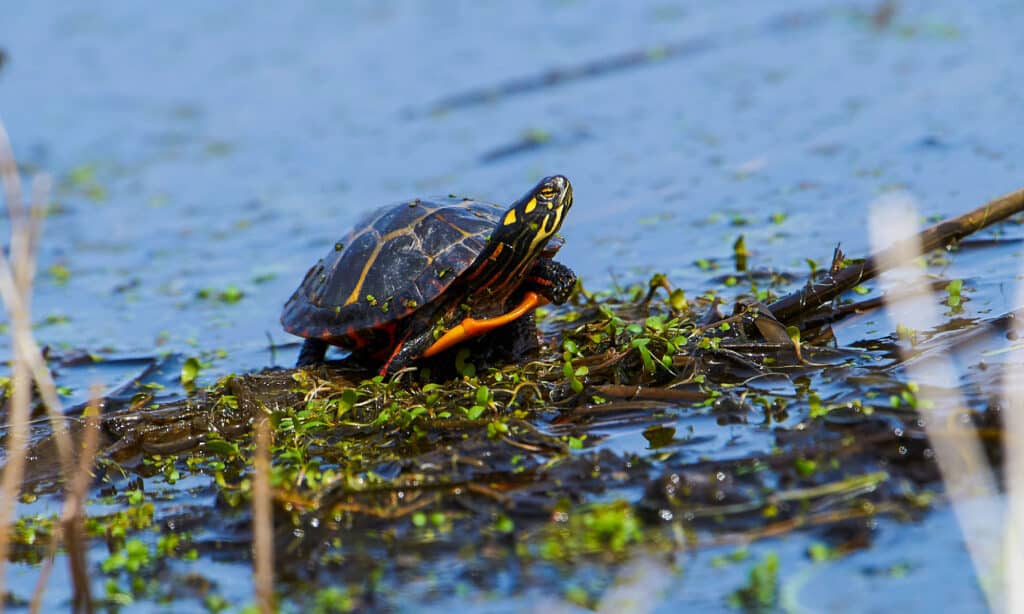
It can be a challenge to tell the difference between eastern painted turtles and midland painted turtles.
©iStock.com/Wildpix645
Closely related to the aforementioned midland painted turtle, the eastern painted turtle subspecies also resides in Maryland. It’s a bit smaller than the midland subspecies at 5 to 7 inches long, and it notably lacks the midland subspecies’ dark brown shadow on its plastron.
Aside from this, it very closely resembles the midland painted turtle, making the two a bit difficult to tell apart from a distance. Its dark brown carapace often has orange or reddish markings around the rim. Also like the other two painted turtle subspecies, its skin is dark green with vibrant yellow striping.
7. Northern Map Turtle (Graptemys geographica)
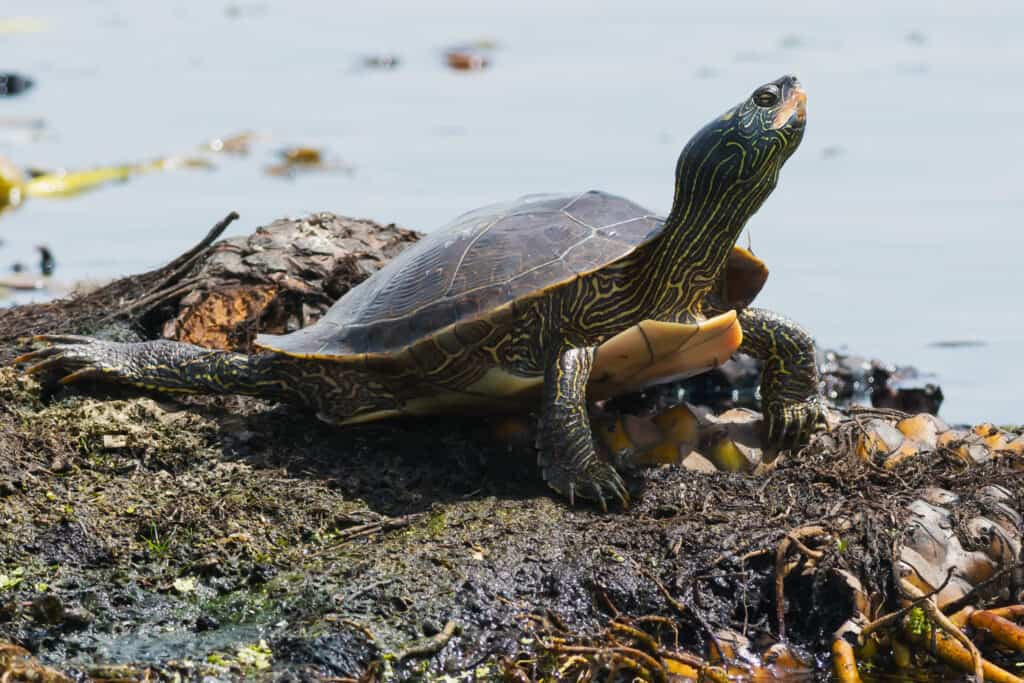
The northern map turtle is endemic to North America.
©iStock.com/PaulReevesPhotography
The northern map turtle gets part of its common name from the light brown webbing-like markings on its carapace, which resemble contour lines on a map! Like the other half of its name implies, its geographic range covers much of the northeast U.S. and the northern Midwest, even extending as far north as southern Canada. Sadly, it is endangered in Maryland, though it can sometimes be found along the state’s northern border.
This unique species varies significantly in size from as little as 3 inches to as long as 11 inches. This is because the males are much smaller than females, averaging 4 to 6 inches long, while females are typically 7 to 11 inches long.
8. Bog Turtle (Glyptemys muhlenbergii)
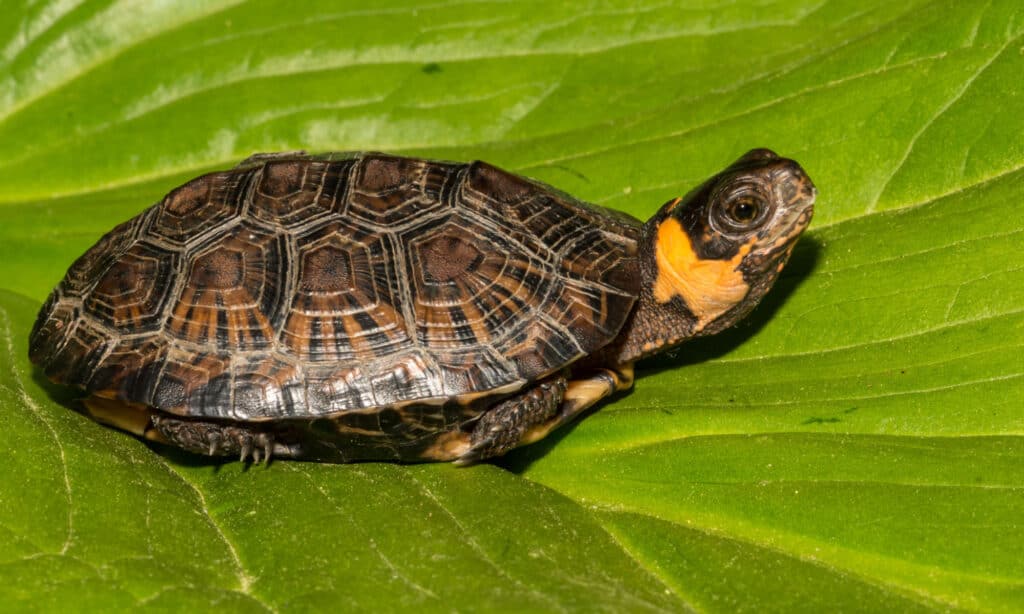
Bog turtles are critically endangered and only live in the eastern United States.
©Jay Ondreicka/Shutterstock.com
The bog turtle is another one of North America’s smallest turtles at just 3 to 4 inches long on average. Due to its small size and fearful, speedy nature, it can be difficult to observe in the wild. Despite resembling painted turtles and pond sliders, it is actually more closely related to the wood turtle, Glyptemys insculpta. It can be easily identified by the bright yellow or orange splotches on either side of its neck.
This little turtle’s geographic range is fairly limited and mainly covers the northeast U.S. states of Maryland, New Jersey, Pennsylvania, and New York. True to its name, it prefers habitats like bogs and marshes, though it can thrive in a wide range of freshwater habitats.
9. Wood Turtle (Glyptemys insculpta)
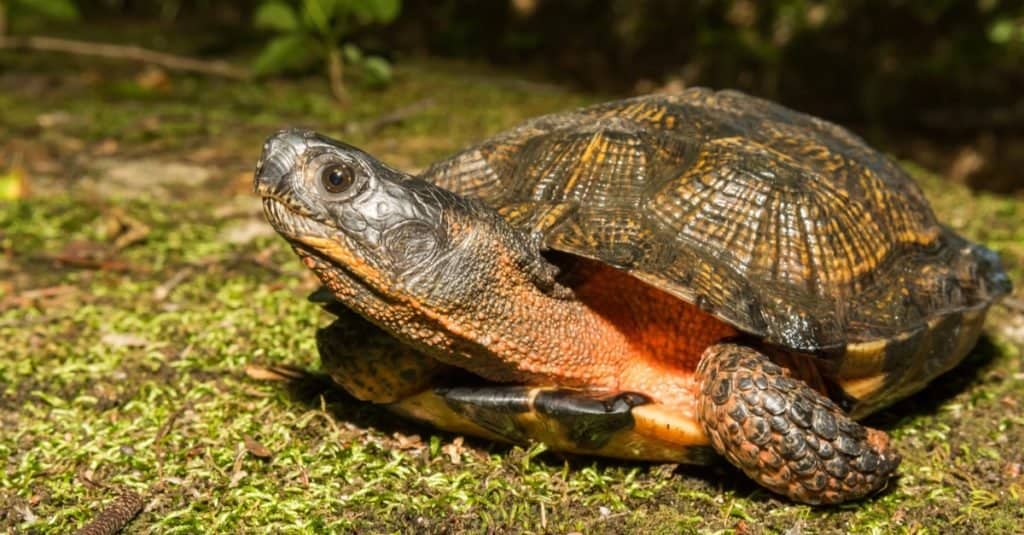
Wood turtles are endemic to North America.
©Jay Ondreicka/Shutterstock.com
The wood turtle gets its scientific name, insculpta, from its rugged, sculpted carapace. Its common name also refers to its carapace, as the raised scutes on its shell have lots of concentric grooves that make it look like wood!
The typical wood turtle is roughly 5 to 8 inches long with a fairly flat, uneven carapace. The underside of its shell, the plastron, is yellow with dark brown splotches. While most of its skin is greyish-brown, its limbs and throat are bright yellow.
Wood turtles can be found throughout Maryland as well as much of the northeastern United States and southern Canada. They prefer forested habitats near freshwater rivers, ponds, and marshes.
10. Northern Diamondback terrapin (Malaclemys terrapin)
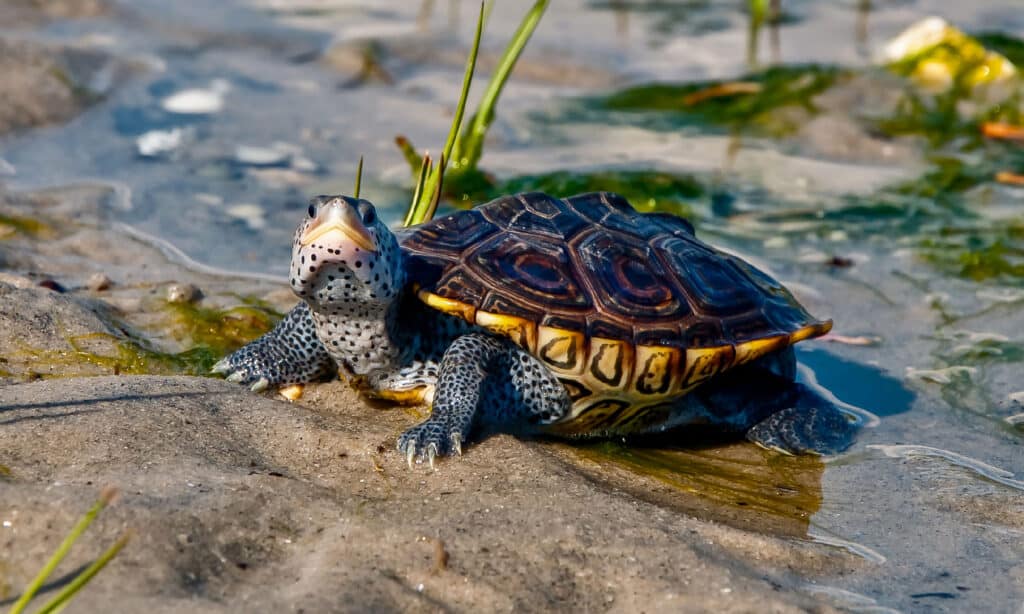
The diamondback terrapin
©iStock.com/JasonOndreicka
The northern diamondback terrapin is one of Maryland’s most unique-looking and beloved reptiles! Not only is it Maryland’s state reptile–it’s also the official mascot of the University of Maryland, College Park. It is one of seven total subspecies of the diamondback terrapin and the only subspecies to reside as far north as New York and Massachusetts.
As its name suggests, the northern diamondback terrapin has a distinct pattern on its mostly brown and tan shell made up of many irregular concentric circular or diamond-like shapes. Its body color can vary, though most individuals have pale gray or tan skin accented by lots of small, mottled dark gray or black markings. Like most sexually dimorphic turtles, females are typically slightly larger than males.
Thanks to their salt-resistant skin and specialized salt glands that allow them to drink sea water, these incredible turtles thrive in brackish, coastal estuaries and marshes. Despite their small size, they’re also powerful swimmers. Unlike sea turtles, though, terrapins stay close to shore and do not migrate seasonally.
Up Next:
The photo featured at the top of this post is © iStock.com/JasonOndreicka
Thank you for reading! Have some feedback for us? Contact the AZ Animals editorial team.




